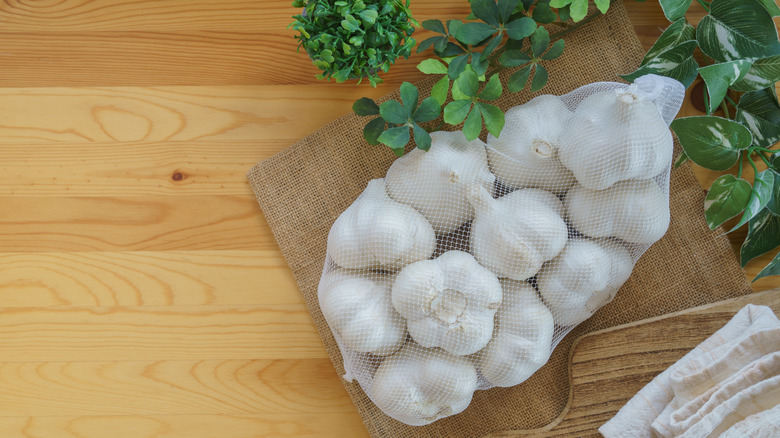Why People Store Garlic In Those Covered Bowls
We may receive a commission on purchases made from links.
Oh, garlic, you kitchen staple and flavor hero, how we covet thee. From garlic bread to Chinese-takeout-style honey garlic crispy beef, it brings intensity and umami to almost every meal (even garlic ice cream). Storing garlic, however, requires more than just affection; you need to know the proper way to keep it to fully enjoy it. But if you've ever wondered whether you store your garlic in the fridge or pantry, or if you've questioned your own storage methods after seeing cloves of garlic from a bowl on the counter, you aren't alone. As it turns out, those bowls are ideal for storing your garlic, and specifically, small countertop bowls with lids and a few small holes, because garlic needs protection.
As potent as it is, it's hard to believe garlic needs shelter. But we've all experienced going to grab some garlic, only to find that it's been busy growing new sprouts while we were away. When garlic is stored in the light, it has a higher chance of sprouting much sooner than if kept in a dark place. This is why covered containers are often a good choice for storage.
As for the holes, those are for airflow. Garlic exposed to moisture is at risk of rotting and growing mold. While it's safe to consume garlic that has new sprouts, it's never wise to eat garlic with mold on it. Whole garlic does best at room temperature, in dark environments with sufficient airflow; peeled or minced garlic will last best in the refrigerator.
Other tips to help your garlic last longer
Garlic containers help slow the rate of sprouting, retain the garlic's firmness, and keep the cloves flavorful, so it might be time to invest in something to hold your garlic. My favorite food storage container for this is the Henry Watson Garlic Keeper. This garlic container is made from terra cotta, which absorbs moisture — great for humid environments. But there are a few other tips to help ensure you're getting the most life out of your garlic.
Make sure you're storing your garlic away from any produce that emits ethylene gas. Ethylene gas can be emitted from produce that continues to ripen even after it's harvested, and exposure to this gas will cause your garlic to spoil faster. Some examples of fruits and vegetables that produce ethylene gas are bananas, avocados, and apples.
Mesh produce bags are also an effective choice for storing garlic, and in fact, it's often sold in these bags at the grocery store. Mesh bags provide airflow while keeping the garlic (and the mess it can make) contained. Another option is to simply place your garlic in a bowl you have on hand. You can store it without a lid away from any sunlight, or you can place a loose cover over the top, like a paper towel or newspaper, to prevent any light from entering. Just don't place anything too heavy or fitted on top, as that will prevent proper airflow.

